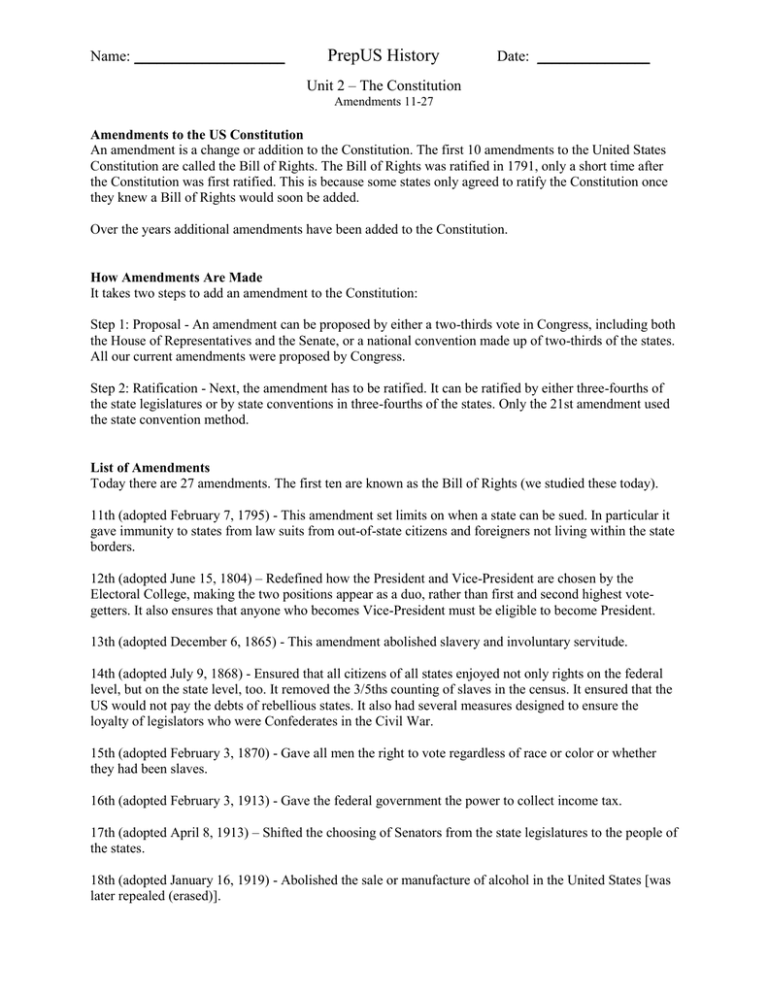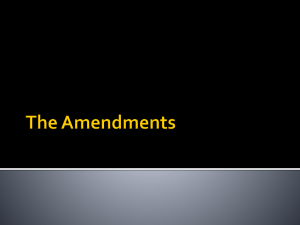PrepUS History Name: ____________________ Date: _______________
advertisement

Name: ____________________ PrepUS History Date: _______________ Unit 2 – The Constitution Amendments 11-27 Amendments to the US Constitution An amendment is a change or addition to the Constitution. The first 10 amendments to the United States Constitution are called the Bill of Rights. The Bill of Rights was ratified in 1791, only a short time after the Constitution was first ratified. This is because some states only agreed to ratify the Constitution once they knew a Bill of Rights would soon be added. Over the years additional amendments have been added to the Constitution. How Amendments Are Made It takes two steps to add an amendment to the Constitution: Step 1: Proposal - An amendment can be proposed by either a two-thirds vote in Congress, including both the House of Representatives and the Senate, or a national convention made up of two-thirds of the states. All our current amendments were proposed by Congress. Step 2: Ratification - Next, the amendment has to be ratified. It can be ratified by either three-fourths of the state legislatures or by state conventions in three-fourths of the states. Only the 21st amendment used the state convention method. List of Amendments Today there are 27 amendments. The first ten are known as the Bill of Rights (we studied these today). 11th (adopted February 7, 1795) - This amendment set limits on when a state can be sued. In particular it gave immunity to states from law suits from out-of-state citizens and foreigners not living within the state borders. 12th (adopted June 15, 1804) – Redefined how the President and Vice-President are chosen by the Electoral College, making the two positions appear as a duo, rather than first and second highest votegetters. It also ensures that anyone who becomes Vice-President must be eligible to become President. 13th (adopted December 6, 1865) - This amendment abolished slavery and involuntary servitude. 14th (adopted July 9, 1868) - Ensured that all citizens of all states enjoyed not only rights on the federal level, but on the state level, too. It removed the 3/5ths counting of slaves in the census. It ensured that the US would not pay the debts of rebellious states. It also had several measures designed to ensure the loyalty of legislators who were Confederates in the Civil War. 15th (adopted February 3, 1870) - Gave all men the right to vote regardless of race or color or whether they had been slaves. 16th (adopted February 3, 1913) - Gave the federal government the power to collect income tax. 17th (adopted April 8, 1913) – Shifted the choosing of Senators from the state legislatures to the people of the states. 18th (adopted January 16, 1919) - Abolished the sale or manufacture of alcohol in the United States [was later repealed (erased)]. 19th (August 18, 1920) - The 19th amendment gave women the right to vote. It’s also called women’s suffrage. 20th (adopted January 23, 1933) - Set new start dates for the terms of the Congress and the President, and clarifies how the deaths of Presidents before swearing-in would be handled. 21st (adopted December 5, 1933) - This amendment repealed the Eighteenth Amendment. 22nd (adopted February 27, 1951) - Limited the president to a maximum of two terms or 10 years. 23rd (adopted March 29, 1961) - Gave the District of Columbia (Washington D.C.) the right to three electors in Presidential elections. 24th (adopted January 23, 1964) - Said that people don’t have to pay a tax, called a poll tax, to vote. 25th (adopted February 10, 1967) - This amendment defined the presidential succession if something should happen to the president. The first in line is the Vice-President. 26th (adopted July 1, 1971) - Set the national voting age at 18. 27th (adopted May 7, 1992) - States that Congressional salary changes can not take effect until the beginning of the next session of Congress. Questions _____ How many amendments to the Constitution are there? A. 10 C. 20 B. 17 D. 27 _____ What are the first ten amendments called? A. The Declaration of Independence B. The Freedom Amendments C. The Bill of Rights E. 50 D. The Big Ten E. The Congressional Laws _____ What is interesting about the 21st amendment? A. It was the final amendment. B. The only thing it did was to repeal the 18th amendment. C. It made the drinking age 21 years old. D. It made age discrimination illegal. E. It was never ratified by the states or the Congress. _____ How many states have to ratify an amendment before it becomes part of the Constitution? A. Zero, as long as there is a majority vote by the people. B. One-fourth D. Three-fourths C. Half E. All of the states have to ratify it. _____ Which amendment prohibited alcoholic drinks from being sold in the United States? A. 12th C. 18th E. 26th th st B. 16 D. 21 _____ What did the 19th amendment do? A. It made slavery illegal. B. It limited the number of years that one person could be president. C. It described in detail the order of succession to the presidency. D. It gave women the right to vote. E. It set the voting age to eighteen years old. 2 _____ What are the two steps that take place before an amendment becomes part of the Constitution? A. Proposal and ratification B. Polling and voting C. Law Review and ratification D. Congressional vote and Presidential signature E. Proposal and Supreme Court stamp of approval Identify, by number, the Amendment (11-27) that each of the following statements refer to: _____ You can not be deprived of the right to vote based on your color or ethnicity as long as you are a U.S. citizen! _____ Taxes or fees may not be changed to a person who wishes to vote in an election. _____ No person may be held in servitude or slavery, regardless of race, color, or creed. _____ If you are born or become a citizen of the United States you are guaranteed equal protection under the law, and may not have your rights taken away or be deprived of the pursuit of life, liberty, or property… (though not specifically stated in the Amendment, this applies to all citizen regardless of color). _____ The official age to vote is 18, and anyone 18 or older may vote in all public elections. _____ Due Process applies to all citizens of the U.S. (this Amendment was written to protect the rights of newly-freed slaves in America). 3


